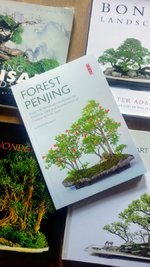I bought several books a couple months ago that I've been working my way through, and so far my favorite has been this one, edition dated 1982.
View attachment 444693
I'd recommend it as an indispensable reference for beginning and intermediate miniature tree people. It touches on the history and various schools of penjing, with large sections for both tree and rock penjing. The aesthetics discussion is heavier in the rock section, but the tree section does go a bit into the relationship between tree and pot as has already been mentioned in this thread.
Since starting it, I've come to the belief that the sort of North American bonsai culture that many people on BNut are looking for will be a bit more along the lines of penjing than Japanese bonsai, but with it's own unique western flair.
In Europe, I suspect it will be closer to bonsai, but with the enormous variety of cultures it's impossible to speak for an entire continent.
Couldn't speak as to other regions of the world.


